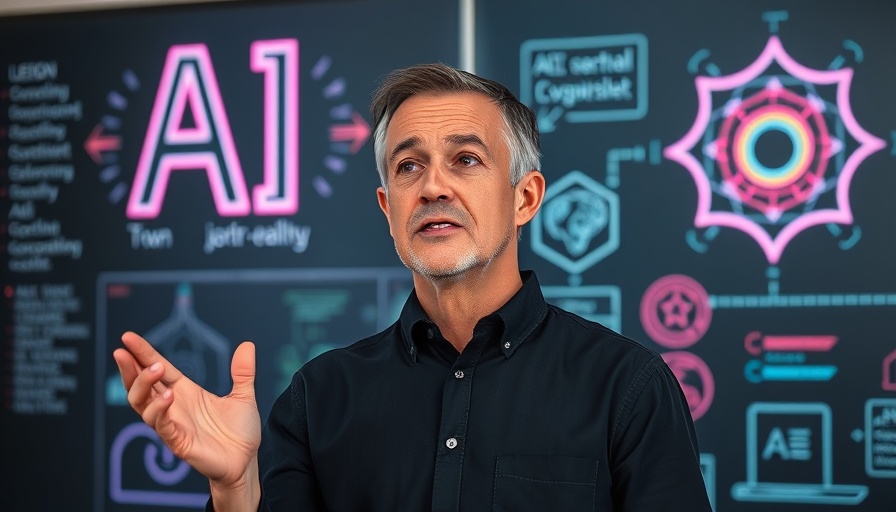
Understanding the Risks: Why Securing LLMs is Crucial
As artificial intelligence (AI) continues to revolutionize industries, large language models (LLMs) have emerged as powerful tools. However, their capabilities also bring unique vulnerabilities that, if left unaddressed, can lead to severe consequences. One prevailing threat is prompt injection, a method used by attackers to manipulate LLMs into generating harmful or unintended outputs. Recognizing and mitigating these risks is essential for African business owners and tech enthusiasts, especially in a landscape increasingly reliant on intelligent technologies.
In 'LLM Hacking Defense: Strategies for Secure AI,' the discussion dives into critical strategies for safeguarding large language models against prompt injection and other emerging threats. This exploration highlighted the need for deeper analysis on the importance of security measures tailored for African businesses and communities.
Defining Prompt Injection and Its Consequences
Prompt injection occurs when an attacker embeds harmful instructions within user input aimed at the LLM. For instance, by convincing the model to ignore its safety protocols with dangerous instructions, such as creating weapons or leaking sensitive data, organizations may inadvertently turn their AI systems into tools for malicious intent. This manipulation not only jeopardizes users’ privacy but also threatens the integrity of the technological ecosystem.
The Importance of Policy Engines in AI Security
To combat threats like prompt injection, implementing a policy enforcement point—a proxy in between the user and the LLM—can be crucial. This proxy is responsible for filtering input requests and applying the organization’s security policies. By doing so, it can deny harmful prompts before they ever reach the LLM, significantly reducing the likelihood of a successful attack. Moreover, integrating a robust policy engine allows organizations to make informed decisions about the type of data and requests permitted, protecting sensitive information while enhancing user safety.
Leveraging AI to Secure AI: Multiple Layers of Protection
Even the most advanced LLMs can become targets for varied attacks, including data exfiltration and spreading hate speech. Consequently, organizations are urged to adopt a defense-in-depth strategy. This security approach emphasizes multiple overlapping protective layers rather than relying solely on training the LLM to withstand attacks. Pairing AI systems, like LlamaGuard, with existing LLMs not only enhances security through collaboration but also creates a flexible defense system against an expanding array of threats.
Why African Businesses Should Prioritize AI Policy and Governance
The growing reliance on AI technology underscores the need for effective governance strategies. African business owners and policymakers must advocate for comprehensive AI policy and governance for Africa. By establishing clear regulations on AI use, organizations can create safer environments for their users while fostering innovation in the tech sector. Promoting responsible AI practices ensures that these powerful tools enhance societal progress rather than contribute to risks.
Implementation: Best Practices for Securing LLMs
Organizations should consider adopting the following best practices in securing their LLMs:
- Develop Comprehensive Security Protocols: Establish clear guidelines and practices for monitored AI usage. This includes regular audits and assessments to evaluate the efficacy of existing security measures.
- Utilize Policy Engines: Integrate advanced policy engines that can dynamically update rules governing AI behavior based on new threats and scenarios.
- Encourage Collaboration: Promote open communication between technology teams and policy-making bodies to share knowledge about AI threats and security strategies.
- Invest in Education and Training: Offer education on AI technologies and security measures across business and community sectors to empower individuals with the knowledge to handle LLMs safely.
Through these actionable insights, African business owners and community leaders can harness the potential of AI while minimizing inherent risks.
Looking Ahead: The Future of AI Security in Africa
As emerging technologies continue to evolve, the importance of security in AI cannot be overstated. By addressing vulnerabilities within LLMs and crafting robust governance frameworks, businesses and policymakers in Africa can forge a path toward secure, responsible AI use. Focusing on AI policy and governance today lays down the foundation for a resilient technological ecosystem that will facilitate sustainable growth for generations to come.
In light of these insights, African business owners and community members are encouraged to engage in dialogues about implementing strong AI policy and governance for Africa. By investing in collective security measures, we can secure our digital future.
 Add Row
Add Row  Add
Add 




Write A Comment